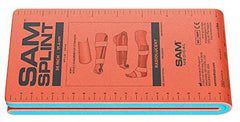First Aid in the Wilderness: A Guide to Wilderness First Aid Kits

Why You Need a Wilderness First Aid Kit
In the wilderness, help is often hours away. That’s why first aid in the wilderness requires not just the right supplies—but the knowledge to use them. A Wilderness First Aid Kit is a piece of gear that should come on every backcountry trip. Whether you're backcountry skiing or splitboarding, rock climbing, mountain biking or any outdoor activity with potential for injury, a wilderness first aid kit is an essential component of any outdoor enthusiasts' gear list.
What to Include in a Wilderness First Aid Kit
Wilderness first aid kits should be stocked with supplies to address minor injuries, basic medical emergencies, and serious trauma. First aid kits should be optimized for the demands of whatever activity you're going to be doing. For technical and high-altitude climbing where you may be pushing your limits and every gram counts, you may need to pare down your kit to make climbing easier. For backcountry skiing and general mountaineering, a heavier kit with more supplies may be appropriate.

Whatever activities you're planning on undertaking, be prepared to address the following situations:
- Addressing Minor Cuts and Blisters (try to treat hot spots before they become blisters!)
- Clean, Dress and Bandage Wounds and Burns
- Splint and Swath Fractures
- Support Sprains
- Provide Support for Medical Emergencies
Remember to keep in mind other items that you will have with you that might be useful in treating trauma. Trekking poles, tree branches or closed cell foam pads can make great improvised splints. Ziplock bags can be made into an improvised irrigation by simply filling them with water and poking a tiny hole in them to create a forceful water stream to clean wounds. Backpacks can be used as slings or swaths.

In the backcountry, we can't carry all of the specialized first aid supplies we might want to. We're limited by weight and space in our packs, and we have to prioritize critical items and carry items that are versatile. With a small assortment of critical first-aid specific supplies and some resourcefulness and improvisation, we can address a huge variety of injuries, even in remote, wilderness areas.
Here are the items that I keep in my first aid kit for a typical backcountry skiing or general mountaineering trip:

I've found it easiest to start with a store-bought first aid kit and modify it to meet my needs. My Wilderness First Aid Kit, shown above, started with a Hart Medical Weekend First Aid Kit. I find this kit to be the right size: big enough to just fit everything I might need to manage a serious incident. After purchasing the kit, I swapped out a few items and added some extras.
So, here is what's in a wilderness first aid kit for backcountry skiing and general mountaineering.
Download the List Here
Minor Injuries
- Assorted adhesive bandages (fabric preferred)
- Blister treatment (KT Tape)
- Triple Antibacterial ointment (e.g., bacitracin)
- 3 Pairs Medical / surgical gloves (nitrile preferred; avoid latex. If you need these, you will use more than 1 pair!)
Wounds
- Antiseptic wipes (BZK-based wipes preferred; alcohol-based OK)
- Butterfly bandages / adhesive wound-closure strips
- Gauze pads (various sizes)
- Non Adhesive sterile pads
- Rolled gauze
Multipurpose Items and Tools
- Head Lamp (Mini, like Petzl eLite)
- Medical adhesive tape (10 yd. roll, min. 1" width)
- Duct Tape
- Small Pocket Knife
- Trauma shears (blunt-tip scissors)
- Splinter tweezers (fine-point)
- Safety pins (for fixing bandages / slinging & swathing)
- First-aid manual or information cards
- Small Elastic wrap (Ace bandage)
Medicines and Topical Treatments
- Aspirin (primarily for response to a heart attack)
- Ibuprofen (anti inflammatory) / other pain-relief medication
- Glucose or other sugar (to treat hypoglycemia)
- Insect sting / anti-itch treatment
- Antihistamine to treat allergic reactions
Optional Items to Consider
-

- Tourniquet. These life-saving tools are an essential part of any kit on trips with potential for serious injury or laceration. They have become more favored for lay-rescuer use after positive results in testing during the Iraq War. Spinning Version, SWAT-T.

- SAM Splint. A versatile splint that can help manage a number of fractures and sprains is worth considering.
- CPR mask (Lay person CPR no longer requires rescue breaths, so may not be necessary)
- Small notepad with waterproof pencil or pen (can also use smartphone)
- Medical waste bag
- Waterproof container to hold supplies and meds
- Emergency heat-reflecting blanket
- Triangular cravat bandage
- Compound tincture of benzoin (bandage adhesive)
- Hemostatic (blood-stopping) gauze
- Liquid bandage
- Hand sanitizer (in addition to Sani-Wipes)
- Epi-Pen Injectable epinephrine (for severe allergic reactions)
Beefing up your Medications/Treatments for Extended Trips
- Diarrhea medication
- Antacid tablets
- Sunburn relief gel or spray
- Prescription medications (e.g., antibiotics)
- Throat lozenges
- Lubricating eye drops
Where to Learn Wilderness First Aid
Carrying a well-stocked kit is only half the equation—knowing how to use it is what really matters.
For those heading into the backcountry, a formal training course is the best way to build confidence and preparedness. We offer both the Wilderness First Aid (WFA) and Wilderness First Responder (WFR) courses in Tahoe, led by seasoned professionals including a certified paramedic and former fire chief.
These hands-on courses teach essential skills like patient assessment, splinting, wound care, and evacuation decision-making—everything you need to manage medical situations when help is hours away.
About the Author
Zeb Blais is an IFMGA Mountain Guide and AIARE Course Leader based in Truckee California. He loves all the disciplines of mountain guiding - ski, rock and alpine climbing - but skiing is his first love. In the winter he enjoys backcountry skiing, guiding local and international ski trips, and teaching avalanche courses across the west coast, from Bishop, California to Mt Baker, Washington.
